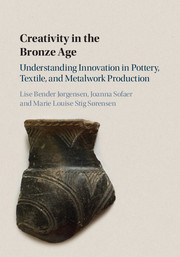Book contents
- Creativity in the Bronze Age
- Creativity in the Bronze Age
- Copyright page
- Contents
- Figures
- Tables
- Contributors
- Preface and Acknowledgements
- Introduction
- Part I Raw Materials: Creativity and the Properties of Materials
- Part II Production Practices
- Part III Effects: Shape, Motifs, Pattern, Colour, and Texture
- Conclusion
- References
- Index
- References
References
Published online by Cambridge University Press: 28 December 2017
- Creativity in the Bronze Age
- Creativity in the Bronze Age
- Copyright page
- Contents
- Figures
- Tables
- Contributors
- Preface and Acknowledgements
- Introduction
- Part I Raw Materials: Creativity and the Properties of Materials
- Part II Production Practices
- Part III Effects: Shape, Motifs, Pattern, Colour, and Texture
- Conclusion
- References
- Index
- References
- Type
- Chapter
- Information
- Creativity in the Bronze AgeUnderstanding Innovation in Pottery, Textile, and Metalwork Production, pp. 301 - 334Publisher: Cambridge University PressPrint publication year: 2018



